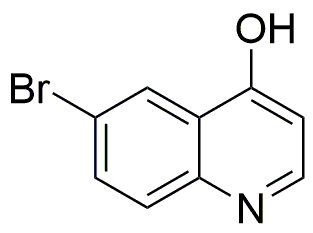6-Bromo-4-hydroxyquinoline is widely utilized in research focused on:
- Pharmaceutical Development: This compound serves as a key intermediate in the synthesis of various pharmaceuticals, particularly those targeting bacterial infections and cancer therapies.
- Antimicrobial Agents: It is effective in developing new antimicrobial agents, offering potential advantages over traditional antibiotics by targeting resistant strains.
- Fluorescent Probes: The compound is used in creating fluorescent probes for biological imaging, which help researchers visualize cellular processes in real-time.
- Analytical Chemistry: It plays a role in analytical methods for detecting metal ions, enhancing the sensitivity and selectivity of assays used in environmental monitoring.
- Material Science: This chemical is explored in the development of advanced materials, such as organic semiconductors, due to its unique electronic properties.
Información general
Propiedades
Seguridad y normativas
Aplicaciones
6-Bromo-4-hydroxyquinoline is widely utilized in research focused on:
- Pharmaceutical Development: This compound serves as a key intermediate in the synthesis of various pharmaceuticals, particularly those targeting bacterial infections and cancer therapies.
- Antimicrobial Agents: It is effective in developing new antimicrobial agents, offering potential advantages over traditional antibiotics by targeting resistant strains.
- Fluorescent Probes: The compound is used in creating fluorescent probes for biological imaging, which help researchers visualize cellular processes in real-time.
- Analytical Chemistry: It plays a role in analytical methods for detecting metal ions, enhancing the sensitivity and selectivity of assays used in environmental monitoring.
- Material Science: This chemical is explored in the development of advanced materials, such as organic semiconductors, due to its unique electronic properties.
Documentos
Hojas de datos de seguridad (HDS)
La SDS proporciona información de seguridad completa sobre la manipulación, el almacenamiento y la eliminación del producto.
Especificación del producto (PS)
La PS proporciona un desglose completo de las propiedades del producto, incluida la composición química, el estado físico, la pureza y los requisitos de almacenamiento. También detalla los rangos de calidad aceptables y las aplicaciones previstas del producto.
Certificados de análisis (COA)
Busque certificados de análisis (COA) ingresando el número de lote del producto. Los números de lote y de partida se pueden encontrar en la etiqueta de un producto después de las palabras "Lote" o "Lote".
Número de catálogo
Número de lote/lote
Certificados de origen (COO)
Este certificado de origen confirma el país en el que se fabricó el producto y también detalla los materiales y componentes utilizados en él y si se deriva de fuentes naturales, sintéticas u otras fuentes específicas. Este certificado puede ser necesario para cumplir con las normativas aduaneras, comerciales y regulatorias.
Número de catálogo
Número de lote/lote
Hojas de datos de seguridad (HDS)
La SDS proporciona información de seguridad completa sobre la manipulación, el almacenamiento y la eliminación del producto.
DownloadEspecificación del producto (PS)
La PS proporciona un desglose completo de las propiedades del producto, incluida la composición química, el estado físico, la pureza y los requisitos de almacenamiento. También detalla los rangos de calidad aceptables y las aplicaciones previstas del producto.
DownloadCertificados de análisis (COA)
Busque certificados de análisis (COA) ingresando el número de lote del producto. Los números de lote y de partida se pueden encontrar en la etiqueta de un producto después de las palabras "Lote" o "Lote".
Número de catálogo
Número de lote/lote
Certificados de origen (COO)
Este certificado de origen confirma el país en el que se fabricó el producto y también detalla los materiales y componentes utilizados en él y si se deriva de fuentes naturales, sintéticas u otras fuentes específicas. Este certificado puede ser necesario para cumplir con las normativas aduaneras, comerciales y regulatorias.


